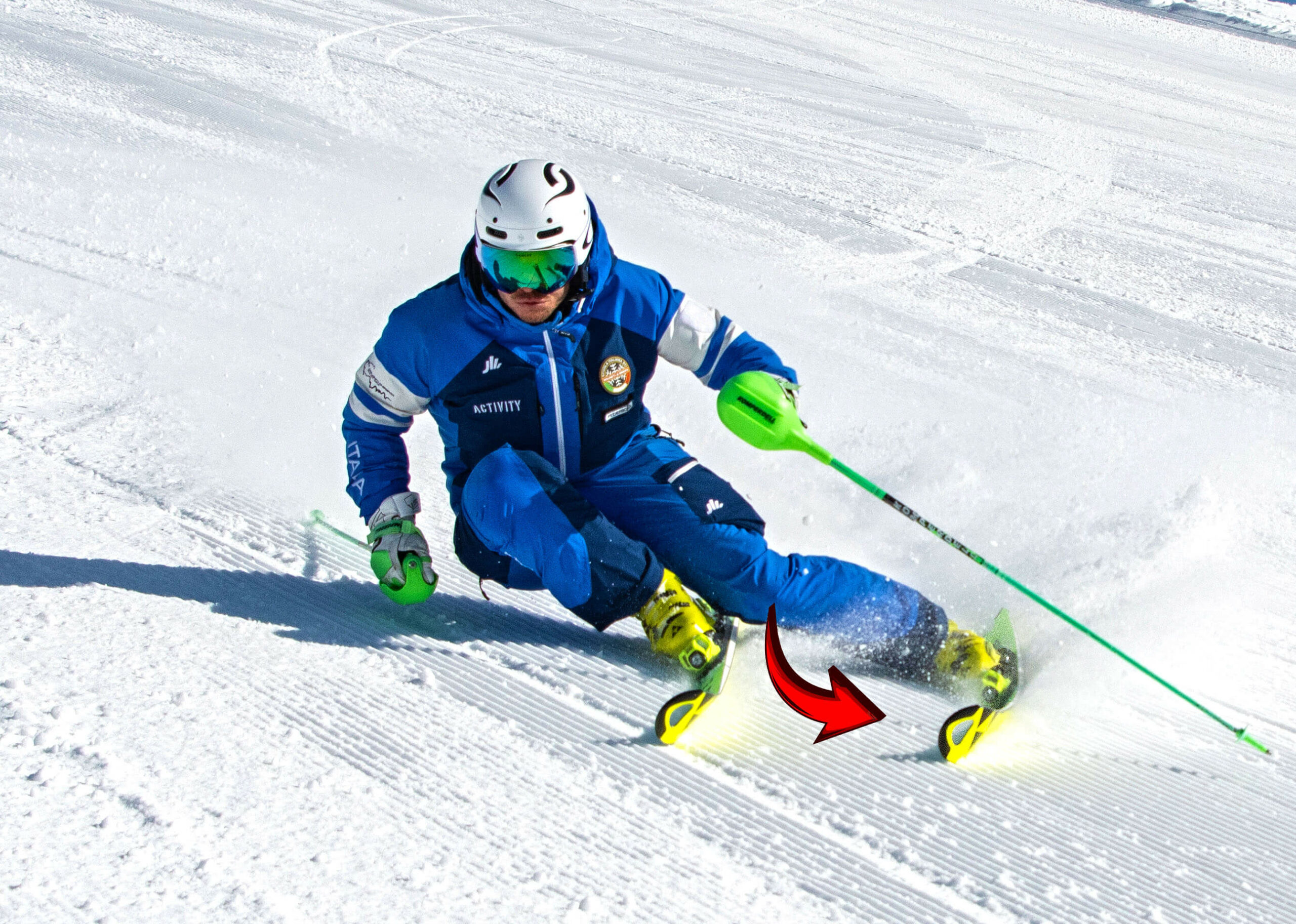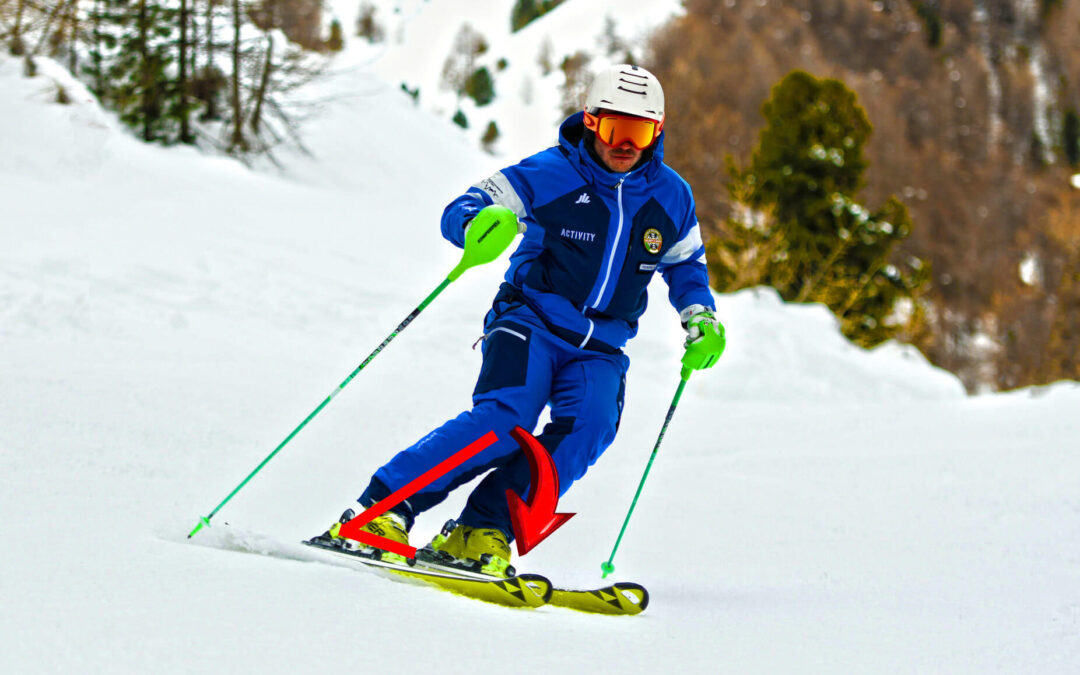If I had to choose one simple thing about top-level ski technique, would be that of ankle flexion. More so, if I had to pick the one thing that separates good skiers from really experts, would be that of the ankle flexion great skiers can generate at the top of the turn.
Regarding skiing technique main fundamentals, in addition to having an athletic stance, outside ski main balance, and a stable upperbody, ankle flexion is the other absolutely key aspect for high-performance turns. Ankle flexion is something paramount and critical to effective skiing. So let’s deep dive into it…
CLARIFICATION: It is accurate to point out that for the skier to be in the athletic stance (AKA basic position) and remain in balance (fore-aft), it is mandatory to always have some amount or degree of ankle flexion. It is this ankle flexion what allows us to be centered on the skis and in a position where we can “attack”, instead of being “reactive” in our skiing.
Having said that, on this post we are referring to “ankle flexion” as the brief movement of increasing the amount of flexion on the outside ankle primarly, that occurs at turn initiation. That is, using the shin muscles (tibialis anterior) to close the angle between the shin and the top of our foot (also referred to as ankle dorsiflexion).
The Why
Elite skiers can strongly flex the outside ankle and really “crush” the front part of the boot (generating the so-called boot-tongue pressure) at the beginning of the turn. They are great in driving the shin forward into the boot at initiation. They do so in order to initiate with the ski tip. It is well known that to start the turn correctly we have to make the outside ski tip “bite the snow” first, by loading or pressuring it. This is mainly achieved through the rapid flexing of the outside ankle and pressing the shin against the tongue of the boot. Getting that ski tip pressure (or ”bite”) without flexing the ankle and squeezing the front part of the boot is almost impossible. Therefore, this movement of increasing the ankle flexion is mandatory to really get on top of your turn, and not to “fall behind”.
Even though in this article we focus mainly on the outside ankle, because it is the ankle of the stance ski, we should always look for to have matching ankle flexion on both ankles to be in the athletic stance. However, remember that the weight should be on the outside ski, so the inside boot tongue is never pressed or loaded.
It worths nothing mentioning that the steeper the slope, the more difficult it is to achieve that much sought “ski tip pressure”. In the steeps, we need to move even more forward in order to remain centered on the skis (AKA “perpendicular to the slope”), and the ankle flexion becomes even more tricky to get. That’s why only the best skiers can really perform on steep terrain.

In the picture above at the Seceda slopes in Val Gardena (amazing Italian Dolomites) you can see I’m pressuring the front part of the outside ski by driving the knee forward and down. It is clear that the shovel of the ski is quite flexed. Also please note that only the outside ski is deflected, and the inside ski remains straight because it is mainly unloaded. I’m 100% over the outside ski.
Ways to achieve ankle flexion:
There are several ways to generate ankle flexion or rather, there are some different “approaches or methods” to get it. But they all produce the same outcome, closing the front angle between the leg and the foot, thus increasing the shin-tongue pressure and the forward pressure on the shovel of the ski:
a) driving the knee forward
b) pulling the foot back using the hamstring muscles
c) lifting the forefoot up inside the boot (to activate the tibialis anterior muscle)
d) a combination of the previous
For me in particular, moving or driving my outside knee forward while pulling my feet back (as a compound movement) is my preferred way to get strong ankle flexion at initiation. Anyway, the most common tip I’ve heard from race coaches is “option a”, that of trying to drive the outside knee forward in order to “put the knee over the toes”. «Try to find the front of the boots. «Knees to the skis!”
Ankle flexion is a quite counter-intuitive movement, that requires a lot of concentration and some expertise to perform it, and even more to really embrace it. It is a skill that takes a while to master, so if it seems difficult at first, don’t give up and keep trying! It is worth it!
When to do it
We should point out that this movement of increasing the ankle flexion and really «whacking hard” the front part of the boot is only done at turn initiation. Why is that? Because in good skiing the pressure on the ski translates from tip to tail throughout the turn. This is generated because the skier’s main plantar pressure point should always move from front to back in the foot, during each turn.
We use the entire ski (the “whole length of the tool”) in order to turn effectively. So, at the beginning of the turn we make the tip of the ski bite, then at the middle of the turn the center part of the ski, and at the end the tail of the ski is what is pressured against the snow. Finishing on the tails “closes” the turn properly, and propels us into the next one. Also, some speed is generated this way (key implication for racing).
Therefore, the fore-aft balance is dynamic, not static. It is in a constant cycle. In normal high-level skiing, skiers always go from being back at the end of one turn to being forward at initiation of the next one (as discussed here).
The more ankle flexion at initiation the better the skier
One study published in 2010 by T. Keränen et all. (LINK!!!), compared two groups of FIS-ranked athletes, group 1 ranked higher than group 2. This study demonstrated that both groups had the same kind of center of plantar pressure front-to-back movement, which is associated with the ski’s bending pattern during the turn (from tip to tail). The difference was that the higher-ranked athletes were able to produce more force in the frontal part of the foot (and thus to the ski tip) at turn initiation, than the group ranked lower.

In the picture above at the 2021 Killington (Vermont) Slalom World Cup, the G.O.A.T. Mikaela Shiffrin shows extreme outside ankle flexion. Please take a look at how close the outside knee is to the outside ski tip. Freaking A-mazing!!!
Testimonials
Jett Seymour is a US Ski Team Athlete from Steamboat Springs (Colorado), competing in Slalom and Giant Slalom. Sam Maes is a Belgium WC Athlete part of Team Global Racing. He was born in Belgium, but was raised in Austria. He competes in Slalom and Giant Slalom disciplines.
“Ankle flexion is the most simple fundamental thing everyone needs to have in their skiing. It allows you to be in a position where you can attack. It also allows you to build speed and pressure the ski. I try to flex my outside ankle hard, absolutely crush it at the top of the turn.”
«Driving the outside knee forward at the start of the turn is key in order to press the front part of the ski, and so when you then tip the knees inwards, you get that ski tip to bite. In this way the skis initiate correctly and the rest of the turn gets a lot easier. So the first and most important thing for me is to get the tip to initiate, and that I do by driving the outside knee forward first, and then in. Every turn starts like that. A lot of recreational skiers are too stiff in their knees and there is no knee drive forward, so they get no pressure of the shin against the tongue of the boot.»
A note on equipment
It is very important to point out that a big enemy of achieving ankle flexion is boots that are too stiff for the skier’s strength and/or ability level (flex number too high). So it is really important to use the proper ski boot for our body and/or skiing level in order to really achieve this ankle flexion at the top of the turn.
Keep ripping some arcs!


Recent Comments